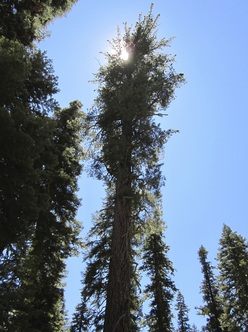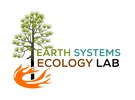
JFSP - Fuels treatment effects on carbon stocks and insect induced mortality 10-years after treatments
Research Team: Matthew Hurteau, Malcolm North, George Koch, Dave Rizzo, Harold Zald, Morgan Wiechmann, Ashley Hawkins
Objectives: The objective of this research is to quantify 10-year post-treatment biomass allocation, insect and pathogen induced mortality, and the influence of insect and pathogen mortality on fuel beds at the Teakettle Experimental Forest. This work builds upon our immediate pre- and post-treatment comparison of carbon stocks (North et al. 2009) and will allow us to validate our efforts to model the carbon payback period of the suite of treatments (Hurteau and North 2010).
Approach: This project leverages on-going experimental efforts at the Teakettle Experimental Forest. The Teakettle Experiment included mechanical and prescribed fire treatments and sought to quantify the effects of these different management actions on a range of ecosystem attributes. The funding for this project has allowed for a complete re-inventory and remapping of all trees within the experimental boundary, 72 hectares of forest! We have also remeasured insect and pathogen impacts, surface fuels, regeneration, and understory vegetation. Additionally, we set out to determine if the growth form of large trees changed following treatment. During our 7-year post-treatment measurement we noticed that a number of the large trees (>75 cm DBH) did not show a measurable growth response at breast height. Since we know that if a tree isn’t growing, it is dying, we hypothesized that these trees were allocating growth further up the trunk to support increased branch and foliage growth. To test this hypothesis, we cored 75 large trees at DBH, the base of the live crown, and at approximately 2/3 of the total tree height. We will use these cores to examine growth patterns before and after treatment at the different heights.
Potential Impact: The results of this project will improve our understanding of post-treatment carbon dynamics over a longer time scale in Sierran mixed-conifer forest. We will also have a better understanding of post-treatment growth response in old-growth trees.
Research Products:
Papers
Wiechmann, M.L., M.D. Hurteau, M.P. North, G.W. Koch, L. Jerabkova. In press. The carbon balance of reducing wildfire risk and restoring process: an analysis of 10-year post-treatment carbon dynamics in a mixed-conifer forest. Climatic Change.
Only half of the table of C stock values is in the original article. The erratum with the full table is here.
Presentations
Zald, HSJ, MD Hurteau, GW Koch, MP North. Growth responses of old growth trees to climate along a vertical canopy gradient. 2014
meeting of the Ecological Society of America.
Wiechmann, ML, KL Martin, MP North, MD Hurteau. Carbon recovered following different fuel reduction treatments in a Sierra Nevada
mixed-conifer forest. 2013 meeting of the Ecological Society of America.
Hawkins, AE, DM Rizzo. Pathogen and pest responses to forest management in the southern Sierra Nevada. 2014 meeting of the American Pathological Society.
Hurteau, M, M Brooks. Effects of fire on carbon in US dry temperate forest systems. Southern Sierra Fire and Hydroclimate Workshop, 22-24 April 2014.
Research Briefs
10-year post-treatment C dynamics
Research Team: Matthew Hurteau, Malcolm North, George Koch, Dave Rizzo, Harold Zald, Morgan Wiechmann, Ashley Hawkins
Objectives: The objective of this research is to quantify 10-year post-treatment biomass allocation, insect and pathogen induced mortality, and the influence of insect and pathogen mortality on fuel beds at the Teakettle Experimental Forest. This work builds upon our immediate pre- and post-treatment comparison of carbon stocks (North et al. 2009) and will allow us to validate our efforts to model the carbon payback period of the suite of treatments (Hurteau and North 2010).
Approach: This project leverages on-going experimental efforts at the Teakettle Experimental Forest. The Teakettle Experiment included mechanical and prescribed fire treatments and sought to quantify the effects of these different management actions on a range of ecosystem attributes. The funding for this project has allowed for a complete re-inventory and remapping of all trees within the experimental boundary, 72 hectares of forest! We have also remeasured insect and pathogen impacts, surface fuels, regeneration, and understory vegetation. Additionally, we set out to determine if the growth form of large trees changed following treatment. During our 7-year post-treatment measurement we noticed that a number of the large trees (>75 cm DBH) did not show a measurable growth response at breast height. Since we know that if a tree isn’t growing, it is dying, we hypothesized that these trees were allocating growth further up the trunk to support increased branch and foliage growth. To test this hypothesis, we cored 75 large trees at DBH, the base of the live crown, and at approximately 2/3 of the total tree height. We will use these cores to examine growth patterns before and after treatment at the different heights.
Potential Impact: The results of this project will improve our understanding of post-treatment carbon dynamics over a longer time scale in Sierran mixed-conifer forest. We will also have a better understanding of post-treatment growth response in old-growth trees.
Research Products:
Papers
Wiechmann, M.L., M.D. Hurteau, M.P. North, G.W. Koch, L. Jerabkova. In press. The carbon balance of reducing wildfire risk and restoring process: an analysis of 10-year post-treatment carbon dynamics in a mixed-conifer forest. Climatic Change.
Only half of the table of C stock values is in the original article. The erratum with the full table is here.
Presentations
Zald, HSJ, MD Hurteau, GW Koch, MP North. Growth responses of old growth trees to climate along a vertical canopy gradient. 2014
meeting of the Ecological Society of America.
Wiechmann, ML, KL Martin, MP North, MD Hurteau. Carbon recovered following different fuel reduction treatments in a Sierra Nevada
mixed-conifer forest. 2013 meeting of the Ecological Society of America.
Hawkins, AE, DM Rizzo. Pathogen and pest responses to forest management in the southern Sierra Nevada. 2014 meeting of the American Pathological Society.
Hurteau, M, M Brooks. Effects of fire on carbon in US dry temperate forest systems. Southern Sierra Fire and Hydroclimate Workshop, 22-24 April 2014.
Research Briefs
10-year post-treatment C dynamics
